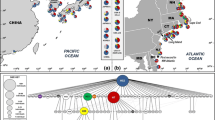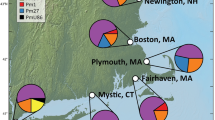Abstract
The closely documented spread of the European periwinkle snail, Littorina littorea from Pictou, Nova Scotia in 1840 to New Jersey by 1870, its near absence in pre-European fossil deposits, and its close association with human mechanisms of transport from Europe, are among the clearest evidence of a human-mediated marine introduction ever reported. Genetic data were recently proposed as evidence that North American L. littorea predate European contact and thus, are not introduced. Review of these genetic data and all other data reveals that the simplest explanation of the modern occurrence of this snail in North America is by human introduction.


Similar content being viewed by others
Abbreviations
- COI:
-
Cytochrome oxydase I
- cytb:
-
Cytochrome b
- ITS:
-
Internal transcribed spacer region
References
Adkins RM, Gelke EL, Rowe D, Honeycutt RL (2001) Molecular phylogeny and divergence time estimates for major rodent groups: evidence from multiple genes. Mol Biol Evol 18:777–791
Ballard JWO, Whitlock MC (2004) The incomplete natural history of mitochondria. Mol Ecol 13:729–744
Berger EM (1977) Gene-enzyme variation in three sympatric species of Littorina. II. The Roscoff population, with a note on the origin of North American L. littorea. Biol Bull 153:255–264
Bird JB (1968) Littorina littorea: occurrence in a northern Newfoundland beach terrace, predating Norse settlements. Science 159:114
Brenchley GA, Carlton JT (1983). Competitive displacement of native mud snails by introduced periwinkles in the New England intertidal zone. Biol Bull 165:543–558
Carlton JT (1979) History, biogeography, and ecology of the introduced marine and estuarine invertebrates of the Pacific coast of North America. Ph.D. Dissertation, University of California, Davis
Carlton JT (1982) The historical biogeography of Littorina littorea on the Atlantic coast of North America, and implications for the interpretation of the structure of New England intertidal communities. Malacol Rev 15:146
Carlton JT (1992) Introduced marine and estuarine mollusks of North America: an end-of-the-20th-century perspective. J Shellfish Res 11:489–505
Carlton JT (1999). The scale and ecological consequences of biological invasions in the world’s oceans. In: Sandlund OT, Schei PJ, Åuslaug V (eds) Invasive species and biodiversity management. Kluwer Academic Publishers, Dordrecht, The Netherlands pp 195–212
Carlton JT (2000) Global change and biological invasions in the oceans. In: Mooney HA, Hobbs RJ (eds) Invasive species in a changing world. Island Press, Washington, D.C, pp 31–52
Carlton JT (2002) Bioinvasion ecology: assessing invasion impact and scale. In: Leppäkoski E, Gollasch S, Olenin S (eds) Invasive aquatic species of Europe. Distribution, impacts, and management. Kluwer Academic Publishers, Dordrecht, The Netherlands, pp 7–19
Carlton JT (2003) Community assembly and historical biogeography in the North Atlantic Ocean: the potential role of human-mediated dispersal vectors. Hydrobiologia 503:1–8
Chapman JW (1988) Invasions of the northeast Pacific by Asian and Atlantic gammaridean amphipods crustaceans, including a new species of Corophium. J Crustacean Biol 8:364–382
Chapman JW, Carlton JT (1991) A test of criteria for introduced species: the global invasion by the isopod Synidotea laevidorsalis (Miers, 1881). J Crustacean Biol 11:386–400
Chapman JW, Carlton JT (1994) Predicted discoveries of the introduced isopod, Synidotea laevidorsalis (Miers, 1881). J Crustacean Biol 14:700–714
Clarke AH (1963a) Supplementary notes on pre-Columbian Littorina littorea in Nova Scotia. Nautilus 77:8–11
Clarke AH (1963b) Littorina littorea as an indicator of Norse settlements. Science 142:1022
Clarke AH (1971) Littorina littorea, native or introduced? Biologist 53:160–162
Clarke AH, Erskine JS (1961) Pre-Columbian Littorina littorea in Nova Scotia. Science 134:393–394
Cosby AW (1993) Ecological imperialism: the biological expansion of Europe, 900–1900. Cambridge University Press, New York
Cunningham CW (2007) How to use genetic data to distinguish between natural and human-mediated introduction of Littorina littorea to North America. Biological Invasions doi:10.1007/s10530-007-9099-8
Dawson MN, Gupta AS, England MH (2005) Coupled biophysical global ocean model and molecular genetic analyses identify multiple introductions of cryptogenic species. Proc Natl Acad Sci 102:11968–11973
Diamond J (1997) Guns, germs, and steel: the fates of human societies. W. W. Norton, New York
Elton CS (1958) The ecology of invasions by plants and animals. John Wiley & Sons, New York
Ganong WF (1886) Is Littorina littorea introduced or indigenous? Am Nat 20:931–940
Ganong WF (1887) Is Littorina littorea introduced or indigenous? Am Nat 21:287–288
Gosner KL (1971) Guide to identification of marine and estuarine invertebrates, Cape Hatteras to the Bay of Fundy. Wiley-Interscience, John Wiley & Sons, Inc., New York
Heltshe JF, Forrester NE (1983) Estimating species richness using the jackknife procedure. Biometrics 39:1–11
Hey J, Nielsen R (2004) Multilocus methods for estimating population sizes, migration rates and divergence time, with applications to the divergence of Drosophila pseudoobscura and D. persimilis. Genetics 167:747–760
Johannesson K (1992) Genetic variability and large scale differentiation in two species of littorinid gastropods with planktotrophic development, Littorina littorea (L.) and Melarhaphe (Littorina) neritoides (L.) (Prosobranchia: Littorinacea), with notes on a mass occurrence of M. neritoides in Sweden. Biol J Linnaean Soc 47:285–299
Kraeuter JN (1976) Offshore currents, larval transport, and establishment of southern populations of Littorina littorea Linne along the U.S. Atlantic coast. Thalassia Jugoslavica 10:159–170
Krebs CJ (1989) Ecol Methodol. Harper Collins Publishers, New York
Kumar S, Hedges SB (1998) A molecular timescale for vertebrate evolution. Nature 392:917–919
Ledig FT, Conkle MT, Bermejo-Velazquez B, Eguiluz-Piedra T, Hodgskiss PD, Johnson DR, Dvorak WS (1999) Evidence for an extreme bottleneck in a rare Mexican pinyon: genetic diversity, disequilibrium, and the mating system in Pinus maximartinezii. Evolution 53:91–99
Lindroth CH (1957) The faunal connections between Europe and North America. John Wiley & Sons, New York, NY
Medcof JC, Clarke AH, Erskine JS (1965) Ancient Canadian east-coast oyster and quahaug shells. J Fish Res Board of Canada 22:631–634
Morris SR (1979) Genetic variation in the genus Littorina, Ph.D. dissertation. University College of Swansea, Wales, UK
Morse ES (1880) The gradual dispersion of certain mollusks in New England. Bull Essex Inst 12:171–176
Nei M, Glazko GV (2002) Estimation of divergence times for a few mammalian and several primate species. J Hered 93:157–164
Nei M, Li W-H (1979) Mathematical model for studying genetic variation in terms of restriction endonucleases. Proc Natl Acad Sci 76:5269–5273
Nielsen R, Wakeley J (2001) Distinguishing migration from isolation: a Markov chain Monte Carlo approach. Genetics 158:885–896
Pederson J (ed) (2000). Marine Bioinvasions. National Conference on Marine Bioinvasions. Massachusetts Institute of Technology, Massachusetts Sea Grant, Cambridge, MA
Petersen KS, Rasmussen KL, Heinemeier J, Rud N (1992) Clams before Columbus? Nature 359:679
Powell JR (1991) Monophyly/paraphyly/polyphyly and gene/species trees: an example from Drosophila. Mol Biol Evol 8:892–896
Reid DG (1996) Systematics and evolution of Littorina. The Ray Society, The Dorset Press, Dorchester, Dorset, England
Spjeldnaes N, Henningsmoen KE (1963a) Littorina littorea: an indicator of Norse settlement in North America? Science 141:275–276
Spjeldnaes N, Henningsmoen KE (1963b) Reply to A. H. Clarke. Science 142:1022
Steneck RS, Carlton JT (2001) Human alteration of marine communities: students beware! In: Bertness MD, Gains SD, Hay ME (eds) Marine community ecology. Sinaur Associates, Inc., Sunderland, MA, pp 445–468
Strasser M (1999) Mya arenaria—an ancient invader of the North Sea coast. Helgolander Meeresuntersuchungen 52:309–324
Sugden AM (2002) Origins of an invasion. Science 297:739
Turgeon DD, Quinn JF Jr, Bogan AE, Coan EV, Hochberg FG, Lyons WG (1998) Common and scientific names of aquatic invertebrates from the United States and Canada: Mollusks, 2nd ed. American Fisheries Society Special Publication, Bethesda, MD
Vermeij GJ (1982) Environmental change and the evolutionary history of the periwinkle Littorina littorea in North America. Evolution 36:561–580
Vermeij GJ (1991) Anatomy of an invasion: the trans-Arctic interchange. Paleobiology 17:281–307
Wagner FJE (1977) Palaeoecology of marine Pleistocene Mollusca, Nova Scotia. Can J Earth Sci 14:1305–1323
Wares JP (2002) Community genetics in the northwestern Atlantic intertidal. Mol Evol 11:1131–1144
Wares JP, Goldwater DS, Kong BY, Cunningham CW (2002) Refuting a controversial case of a human-mediated marine species introduction. Ecol Lett 5:577–584
Webb DA (1985) What are the criteria for presuming native status? Watsonia 15:231–236
Willis J (1863) On the occurrence of Littorina litorea on the coast of Nova Scotia. Trans NS Inst Nat Sci 1:88–90
Acknowledgements
We are grateful to Mitch Cruzan (and students), Portland State University; Mike Behrenfeld, Mark Camara, Michael Banks, and Paul Lang, Oregon State University; George Mpitsos, OSU Hatfield Marine Science Center; Rasmus Nielsen, Cornell University; Jody Hey, Rutgers University; David Reid, The Natural History Museum; Bernd Schoene, Goethe University; Deniz Haydar, University of Groningen, The Netherlands; Amy Chapman, South Beach, Oregon; Katie Chapman, Bowdoin College, Maine; Anthony Ricciardi, Redpath Museum; and John Wares, University of Georgia, for invaluable information, materials and critical comments. We thank the curators of the museums noted above for access to their collections. Financial support for (AMHB) provided by NSF Award OCE 05–03932 to James E. Byers. Susan Gilmont, Judy Mullen, and Janet Webster, Guin Library, OSU, recovered difficult references. We thank the Coastal Ocean Experiment Station for use of their facilities by JWC and MRB. This paper is dedicated to Eliana Sabina Bellinger-Thomas and to Westley James Blakeslee, both born on 12 September 2005.
Author information
Authors and Affiliations
Corresponding author
Rights and permissions
About this article
Cite this article
Chapman, J.W., Carlton, J.T., Bellinger, M.R. et al. Premature refutation of a human-mediated marine species introduction: the case history of the marine snail Littorina littorea in the Northwestern Atlantic. Biol Invasions 9, 995–1008 (2007). https://doi.org/10.1007/s10530-007-9098-9
Published:
Issue Date:
DOI: https://doi.org/10.1007/s10530-007-9098-9




